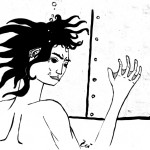 In 2065, a secret supersoldier project resulted in the creation of the first hybrids.
In 2065, a secret supersoldier project resulted in the creation of the first hybrids.
Despite sucessfully splicing human DNA with that of various different species of animal, only two main types of hybrids were mass produced – the primates of the Silva variety and Cat type hybrids. To this day, these two are seen as synonymous with the entire hybrid program.
The hybrid exodus to the Poseidon colony in the latter half of the 22nd century, though, should also bring the forgotten experiments to the fore. First among them the abandoned studies of specialized hybrids for use by naval and marine forces.
Seals
Leopard seal hybrids were designed for landing operations. Less than a hundred of them were bred. The few survivors are suspected to have all migrated to Poseidon with the first wave.
The hybrids can stay submerged for about half an hour, only half as long as a full diving reflex analogue aquaform. Just like these more advanced genies, seals have excellent salt tolerance and insulation against the cold of the ocean.
Seal Modifications:
+2 Build
+1 Fitness
+1 Agility
-1 Dexterity
-1 Presence
+1 Endurance
+2 Aquatics Skill
Otters
It is dubious whether there are any remaining live sea otter hybrids in 2199. The trial series on these amphibious operations hybrids was very small to begin with and was generally regarded as a failure.
Despite retaining a level of manual dexterity unparalleled in the entire program and their excellent agility, the otters‘ low body mass, their low diving endurance (an average of just 10 minutes) and their unique metabolism with its disproportionately huge energy requirements were seen as unacceptable drawbacks.
Otter hybrids possess exceptional salt tolerance. Their ability to resist cold temperatures is based off their overclocked metabolic rate.
Otter Modifications:
+1 Fitness
+2 Agility
-1 Presence
+1 Endurance
+1 Aquatics Skill
Marine Composites
Marine composites were developed – and abandoned – together with the classic multi species composite hybrids (Fluid Mechanics, page 80). Experiences with the sea lion traits used in the composites were later applied – with little added success – in the creation of the seal type hybrids. The other donor species, tortoises, ice bears, sea cows and the experimental use of shark DNA all proved to be dead ends.
They are fully capable of operating in cold saltwater. Their maximum diving time is around 20 minutes.
Marine Composite Modifications:
+1 Build
+2 Fitness
-2 Dexterity
-2 Presence
+1 Awareness (Chemical)
+2 Endurance
+1 Toughness
+1 Aquatics Skill
+1 Swim Speed
Freshwater Composites
Freshwater composites were another attempt at creating hybrids for amphibious use. Instead of marine animals species from freshwater environments were used in their creation, among them water rats, fish otters, predatory freshwater fish, frogs and other amphibians, as well as the crocodile traits also used in regular multi species composites.
The limited under water endurance of ten minutes and the absence of natural salt tolerance reduced the series‘ utility for its core mission profile and resulted in its early termination.
Freshwater Composite Modifications:
-1 Build
+2 Fitness
-1 Dexterity
-2 Presence
+1 Will
+1 Reflexes
+2 Endurance
+1 Aquatics Skill
Blue Planet and all associated names are the Intellectual Property of Biohazard Games and protected by Copyright. These items have been used unofficially and quoted exclusively as reference with no infringement on any associated rights intended and without implying endorsement by the copyright holder. Other contents of this articles are published under the following license:
Creative Commons Attribution-Share Alike 3.0 License
Blue Planet und alle verbundenen Namen sind Geistiges Eigentum von Biohazard Games und urheberrechtlich geschützt. Diese Elemente wurden inoffiziell und ausschließlich als Referenz zitiert ohne die Absicht damit verbundene Rechte anzufechten und ohne eine Billigung durch den Rechteinhaber zu implizieren. Andere Inhalte dieses Artikels werden unter folgender Lizenz veröffentlicht:
Creative Commons Namensnennung-Weitergabe unter gleichen Bedingungen 3.0 Lizenz
